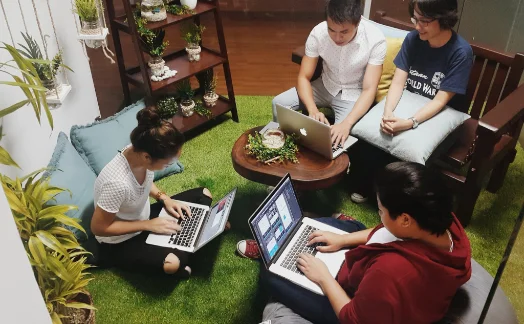After the pandemic, many are finding themselves in a permanent situation with work from home.
The following tips will help you convert your work from a home office into a remote work office.
Home-based work isn't new.
However, the work-from-home mentality has spread globally because of COVID-19.
Over the past 2 years, it has become a requirement for many office workers, who find it as an unplanned and unmanageable necessity.
Many countries are starting to look forward to going back to their offices now that the vaccine has arrived.
Returning to the office is no longer appealing to many employees.
They've discovered the pleasure of not having to spend a lot of time traveling.
As a result of no in-person distractions, employees report higher productivity due to remote working being more convenient.
Employers have also begun to recognize the advantages of this new normal.
They were able to save a lot of money from renting expensive offices.
Even though remote work is becoming more popular, many people are still using improvised, hastily constructed offices that were set up as a result of the pandemic.
They were sufficient as a temporary solution.
Although it is obvious that the proper technology is required but do not overlook the importance of your workspace.
This is critical for avoiding the risks of muscle strains, which can be easily caused by an improperly set up workspace.
It’s important for employers to make sure that their employees have a safe and comfortable environment.
It’s sensible for employees to create offices that are as comfortable as possible since they’ll be spending a lot of time there.
How to Establish a Remote Office

Ideally, a long-term home office should occupy a separate and well-equipped area.
Here are some tips for making your home office a comfortable, user-friendly office that will sustain success for years to come.
Select a Remote Work Office Space

There's no need to stay on the couch any longer.
A small room enough to accommodate a desk, chair, and computer equipment is the ideal space for a home office.
The door should also close completely so you can successfully separate your work and private lives.
The majority of us don't have a dedicated workspace at home.
You can easily transform an existing guest bedroom into a dual-purpose area.
Daytime, it's a space for working, and at night, it's a guest bedroom.
Think about converting a laundry room, enclosed porch, or even a garden shed into a remote working room if you don't have a spare room.
Is it possible to use a friend's or a relative's space if no dedicated space is available?

What matters is that you find a place that is free of distractions and interruptions.
This way, you can concentrate on your work completely.
Adjust the Height of Your Workstation
Work at a desk or table that's at your height.
Work surfaces typically are 29 inches off the ground, which is the industry standard.
A taller person may require a higher surface, while a shorter person may need a lower surface.
The height of many desks can be adjusted to provide comfort to you.
As well, to avoid neck strain, consider buying an adjustable monitor stand.
Setup of a Computer

Provide yourself with ample viewing equipment when it comes to your computer.
At least a 25-inch monitor can alleviate eye strain.
If you have projects that require you to work on one while viewing another twin monitors might be a good idea.
This setup is ideal for many writers, as well as for coders.
Additionally, if you're glued to your screen for a few hours every day, you'll get eye strain if you don't have a high-quality display.
Ideal Office Chair

When you're sitting for a long period of time, the worst thing is bad chairs.
For an hour or two, your dining chairs and deck chairs may feel comfortable, but after six hours or more, you'll want a chair with appropriate foam and back support.
The standard chair is rarely at the proper height, and the posture is less upright.
Find a chair that can adjust in height to meet your needs, as well as arms that can be adjusted laterally with respect to the seat and tilt of the chair.
Additional Remote Workplace Devices
It's also important to select flexible devices for your keyboard, mouse (or touchpad), and speakers.
Wireless keyboards and mice provide more flexibility, especially when participating in group calls and video meetings in a common workspace.
Docking stations are extremely helpful, and headsets are required, particularly for group calls and video meetings.
It's critical to keep your wrists and arms comfortable while using all of these gadgets.
For maximum comfort, an ergonomic keyboard and mouse are a wise investment.
Creating a Remote Work Environment with Lighting
If your office has good natural lighting, you should place your desk and chair in an ideal place in addition to finding the right lighting.
If your workspace does not receive natural light, or if you need to work in an area where the sun does not shine, enhanced lighting may be necessary.
Lighting affects your work more than you might think. Direct light is extremely distracting and can cause headaches and eyestrain.
Make sure the room has sufficient indirect lighting using overhead lights or blinds that diffuse natural light.
High-Speed Internet Access

You need a fast and reliable internet connection if you're a remote worker.
It's also crucial that you have access to all cloud-based systems necessary to complete your work.
Maintaining productivity doesn't happen with slow service and frequent downtime.
In the case of a power outage, a Wi-Fi hotspot on your phone can provide an effective backup.
This provides you with peace of mind and guarantees that you can continue working if your internet service is disrupted due to unforeseen circumstances.
Work with world leading tech businesses
We connect high-performing software engineer talent in the Philippines with some of the world’s leading and most innovative Tech companies.
Submit CV













